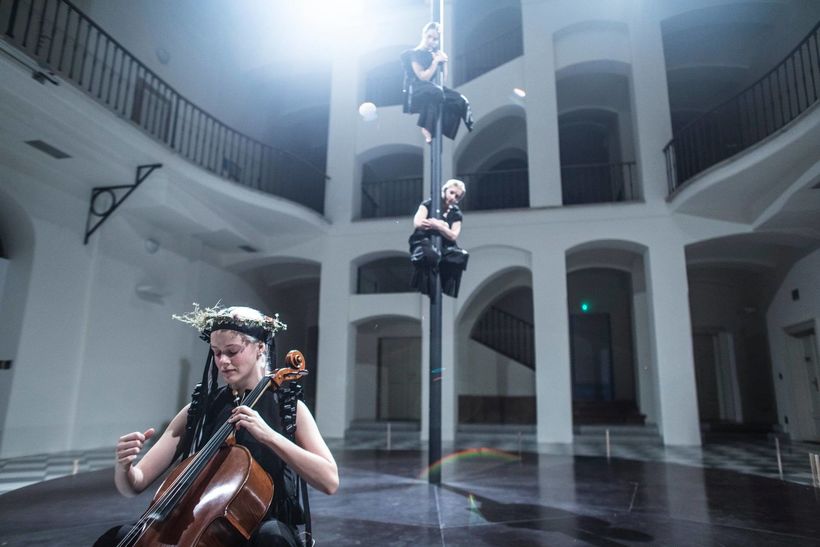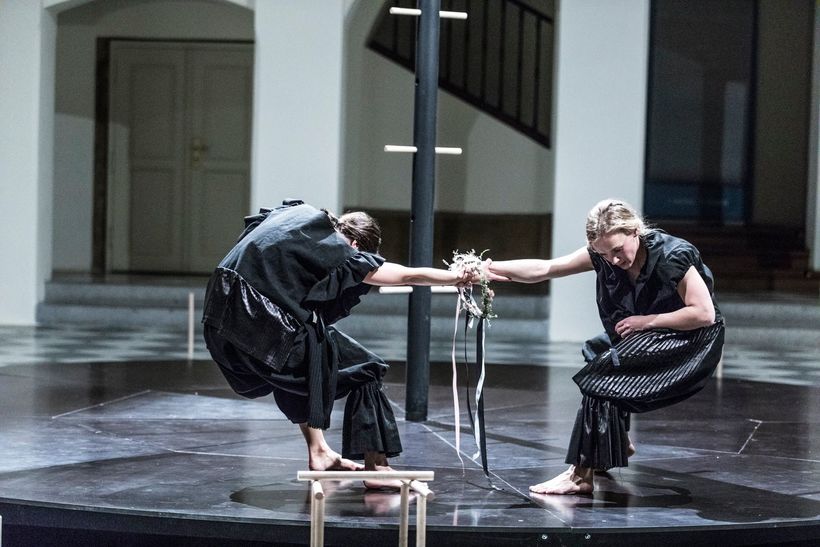Vrány: Holektiv’s poetic dance film
The human world and the world of birds are closely linked. Though we are politically free, looking at birds makes us hungry for freedom. They defy the laws of gravity. They are magical, mysterious, adventurous and romantic creatures. Some kinds of birds carry a hidden, symbolic meaning. They awake visions and premonitions, announce birth and death, they are guardians of ancient mysteries and dark dreams. No wonder they often appear in folk tales, in fables, fairy tales and songs. Crows. They fascinate us. Maybe because we see them so rarely these days. And yet we give them such an unattractive name: corvids.
Holektiv, a company balancing in hights as well as on the ground, premiered a new physical theatre piece at the end of 2020. Like many other artists, they had to opt for a format that would be easy to stream and publish online (instead of a live performance) and so they created an interesting short dance film featuring two dancers and one musician. Taking advantage of the acoustics of the Czech Museum of Music, the performance unfolds on and around a significant stage object by Studio Hermann&Coufal. Its circular floor plan defines the performance space and the central ladder-like wooden pole allows the dancers to enter the aerial space and take a bird’s eye view of the world.
Visually, the performance refers to the taste à la Czech duncanism, especially through the stylized folk and folklore motifs on Michaela Čapková’s costumes. But the main source of inspiration is undoubtedly the music arrangement of selected Moravian folksongs. The musician Terezie Vodička Kovalová sings the tunes, recites texts inspired by folk poetry and accompanies herself on the cello – and does it in a very charismatic way.
In terms of movement, the performance misses the aesthetic goals of duncanism, which comes as no surprise, because Holektiv prefer partner and aerial acrobatics as their main expressive tools. The result looks a little odd but the line of good taste and acceptability is never crossed. In the course of the performance, the two protagonists Andrea Vykysalá and Karolína Křížková tend to abandon the acrobatic presentation and delve into organic and grounded dance movement.
The non-narrative approach allows them to create associative images and the result is a sort of lyrical “story within a story”. The pattern is relatively obvious – on the ground and in the air, the dancers represent crows, standing on their own two feet they turn into humans with all their joys and sorrows. On the ground, the dancers-crows search for food in a dance manner (floorwork), in the air they radiate charisma and serenity. Add the fox from the famous fable and you get a perfect picture.
But in between the earth and the skies, the choreography becomes vague and the performers tend to use flashy acrobatic tricks for no apparent reason (although their balance is truly exquisite). The transitions are random and feel almost naïve, they are vaguely choreographed with inaccurate rhytmization. The question remains whether this is a symbol of ‘misunderstanding’, since some conflicts are portrayed in a very expressive and powerful way (which seems very naïve and random anyway). The motif of a lost and found wreath runs through the performance like a red thread and with a bit of empathy, it is possible to see it as a metaphor of life.
Anyway, working with such an inspiration requires a good understanding of folk traditions which should be reflected in the choreography as well. Folklore-inspired movements are more likely to match traditional folk tunes than acrobatic lifts, arches and hand-stands. On the other hand, aerial acrobatics on a ladder is a perfect way of portraying the world of birds. Both performers are excellent dancers, but sadly, this piece does not give enough space to show their skills. The transformation of a girl into a crow, for instance, is one of the most powerful moments of the piece and there could be more of them.
New circus acrobatics can be exciting and risky but dance poetry has the ability to reach people’s hearts and souls. Vrány is a great choice for dance poetics and putting aside movement, the theatrical elements (like in other Holektiv’s works) are aesthetically tasteful. However, the message comes out as shallow, almost superficial, and unexplicit acrobatic techniques will never make it any deeper. But they will surely please the eye.
Written from online premiere broadcast on 17 December 2020.
Vrány (Crows)
Movement performance on a single object
Concept: Andrea Vykysalá, Karolína Křížková
Performers: Andrea Vykysalá, Karolína Křížková
Directing collaboration: Eliška Brtnická
Stage object: Studio Hermann&Coufal
Music: Terezie Vodičková Kovalová
Costumes: Michaela Čapková
Lighting and sound design: Niels Doucet
Video: Anežka Horová, Tereza Chudáčková
Premiere: 30 October 2020
Online premiere of dance film: 17 December 2020
Translation: Tereza Cigánková.





